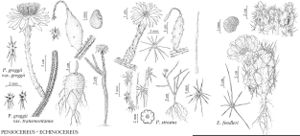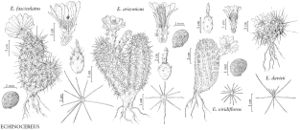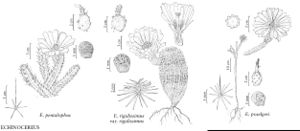Echinocereus
in F. A.Wislizenus, Mem. Tour N. Mexico, 91. 1848.
Plants usually erect, ascending, sprawling, pendent, or decumbent, branched or unbranched, sometimes forming dense mounds to 500 branches, usually not deep-seated in substrate. Roots diffuse (usually a fascicle of several, tuberlike roots greatly exceeding stem diameter in E. poselgeri; sometimes adventitious in E. pentalophus). Stems unsegmented, yellow-green to dark green, spheric to long cylindric, sometimes tapering distally, (1–) 2–70 (–130) [–200] × (0.6–) 1–15 cm, less than 40 cm at flowering, skin hard and brittle (less often soft), tuberculate (especially on immature plants) or ribbed; ribs 4–26, crests indistinctly to prominently undulate (irregularly notched or sharply folded if desiccated); areoles 1–52 mm apart along ribs, circular to linear, never completely confluent; cortex and pith soft, mucilaginous. Spines (0–) 4–55 per areole, white, yellow, reddish, brown, or black, subulate or acicular to bristlelike, (0–) 3–150 × 0.1–2.5 mm, hard, smooth or microscopically roughened (especially in E. triglochidiatus); radial spines (0–) 4–38 (–45) per areole, straight or curved, sometimes pectinately arranged, (0–) 2–40 (–50) mm; central spines 0–17 per areole, straight, curved, or twisted, never hooked, terete, elliptic in cross-section or variously angled to flattened. Flowers diurnal (a few species remaining open at night) [or nocturnal], bisexual (at least appearing so) or functionally unisexual, ± lateral on stem from year-old areoles (rarely terminal), broadly to narrowly funnelform or short tubular, 20–120 × (10–) 15–150 mm; flower tube 5–26 [–50] mm (measured from base of innermost tepals to base of nectar chamber); inner tepals pink, red, magenta, orange, yellow, brownish, or greenish (rarely white), proximally a darker or contrasting color or similar to distal portion; ovary smooth to tuberculate, scales usually minute, spines very prominent, areoles woolly; stigma lobes 5–22, green or yellowish green [rarely white or red]. Fruits indehiscent or dehiscent through short longitudinal slits, green, purplish brown, pink, or red, spheric to narrowly obovoid, usually 20–30 mm, juicy, drying quickly, scales minute; areoles spiny, spine clusters usually deciduous at maturity. Seeds black or dark reddish-brown, spheric to obovoid, 0.8–2 mm, strongly tuberculate or rugose; testa cells strongly convex, sometimes irregularly confluent into ridges with interstitial pits. x = 11.
Distribution
Temperate to tropical regions of w United States and Mexico
Discussion
Species ca. 49 (23 in the flora).
Echinocereus was treated as a distinct North American tribe Echinocereeae Buxbaum before recent chloroplast DNA analyses demonstrated that Echinocereus is nested within tribe Pachycereeae Buxbaum emend. A. C. Gibson & K. E. Horak, including the dominant columnar cacti of North America (R. S. Wallace and A. C. Gibson 2002). Whether Echinocereus and its closest relatives deserve recognition as a subtribe within the newly defined tribe awaits more extensive and intensive DNA investigations of all clades within the tribe.
Many of the species of Echinocereus are confusingly polytypic, having geographic races (not all of them named), and many populations are polymorphic. One “species” (E. pectinatus as circumscribed by L. D. Benson 1982) is polyphyletic.
Although stem growth is indeterminate and branching is lateral, near their bases stems often shrivel and shorten more or less in pace with apical growth, pulling the branch-attachments down to ground level or below. The distance between areoles (interareolar distance), as employed here, is measured from centers of areoles along rib crests on relatively new growth, i.e., before ribs wrinkle. In some species, flower buds and stem-branch buds erupt through the epidermis of the stem adaxial to spine clusters, leaving a permanent scar; a condition referred to as “erumpent.”
The vernacular name strawberry cactus, used for several species, refers to the strawberry-like flavor of the ripe fruits, which are avidly harvested by human foragers. The largest and most sought-after fruits are those of Echinocereus stramineus.
The key below will not work without flowers and/or fruits.
Selected References
Lower Taxa
Key
| 1 | Stem length 8-50 times diam.; roots (one or all of them) tuberlike, several times thicker than stems. | Echinocereus poselgeri |
| 1 | Stem length 1-8 times diam.; roots diffuse, not tuberlike or enlarged | > 2 |
| 2 | Stem length usually 3-8 times diam., semiprostrate or decumbent; s Texas | > 3 |
| 2 | Stems compact, length 1-3 times diam., erect or ascending; mostly widespread | > 6 |
| 3 | Tepals yellow with orange-red or purple proximal regions | Echinocereus papillosus |
| 3 | Tepals pink to purple with white, yellow, green, or purple proximal regions | > 4 |
| 4 | Tepals white or yellow in proximal regions; stem ribs 4-5; areoles of flower and fruit bearing soft hairs to 3-6 mm in addition to spines | Echinocereus pentalophus |
| 4 | Tepals green or purple in proximal regions; stem ribs (5-)7-9(-10); areoles of flower and fruit bearing short wool about 1.5 mm in addition to spines | > 5 |
| 5 | Radial spines to 10 mm; crests of ribs conspicuously undulate or almost completely interrupted between the areoles; stems 1.5-3 cm diam. | Echinocereus berlandieri |
| 5 | Radial spines 9.5-33+ mm; crests of ribs nearly straight on healthy, distal parts of plant (prior to stem shrinkage); stems 3.2-7.5+ cm diam. | Echinocereus enneacanthus |
| 6 | Flowers displaying hummingbird pollination syndrome, having at least one of the following features: inner tepals both crimson/scarlet/carmine and more than 15 mm; tips stiff, strong enough for hummingbirds to perch on, rounded or slightly hooded; anthers pink to (yellowish) purple; inner stamens longer than outer stamens; innermost stamens connate basally forming a tubular extension of the nectar chamber; flowers remaining fully open at night and in cold temperatures | > 7 |
| 6 | Flowers displaying bee pollination syndrome, having inner tepals yellow to brownish or pink to purple, 10-69(-77) mm (carmine and 20-35 mm or less in some populations of E. viridiflorus); inner tepal tips usually somewhat pointed and/or thin and delicate; anthers yellowish; inner stamens shorter than outer, never proximally connate into a tubular extension of the nectar chamber; flowers partly or completely closing at night and in cold temperatures | > 9 |
| 7 | Largest spines usually terete (rarely somewhat flat); inner tepals usually crimson or scarlet; plants dioecious or not, polyploid | Echinocereus coccineus |
| 7 | Largest spines angular or terete in cross section; inner tepals usually carmine or crimson; plants not dioecious, diploid | > 8 |
| 8 | Spines 3-11 per areole, angled and/or papillate (use lens 15×); ribs 5-8; central spines 0-1(-4) per areole; California eastward to Colorado, northern | Echinocereus triglochidiatus |
| 8 | Spines [8-]9-18 per areole, angled to terete; ribs 8-13; central spines 1-8 per areole; Arizona and New Mexico, southern | Echinocereus arizonicus |
| 9 | Inner tepals usually 15 mm or less, greenish or brownish (rarely carmine) | > 10 |
| 9 | Inner tepals 20 mm or more, showy, pink to purple or yellow, at least in distal 1/2 | > 11 |
| 10 | Plants remaining tiny, (1-)2-3 × 1-2(-2.5) cm; ribs 6-9; spines 8-14(-15) per areole; endemic near Marathon, Texas | Echinocereus davisii |
| 10 | Plants larger at maturity, (3-)8-30(-35) × 2.8-9 cm; ribs 10-20; spines (13-)18-30(-55) per areole; widespread (if near Marathon, Texas, then not flowering until much larger than E. davisii) | Echinocereus viridiflorus |
| 11 | Central spines shorter than the longest radial spines, or absent, 2-17(-30) mm; stems usually spheric to short cylindric; plants usually 0-10-branched; interareolar distance short, 3-15 mm; spines ± obscuring stem surface | > 12 |
| 11 | Central spines mostly longer than longest radial spines, usually 20-80 mm; stems elongate, usually short to long cylindric; plants usually branched with age (except in E. fendleri), branches (4-)12-500; interareolar distance relatively long, (12-)15-52 mm; spines obscuring stem surface or often not | > 18 |
| 12 | Flower tube hairs usually less than 3 mm; spines of flower tube thick, more spinelike than bristlelike; young flower buds appearing relatively naked or merely spiny, never completely hidden by vestiture; flowers succulent and durable, re-opening for 2 to several days; flower tube walls thick distally | > 13 |
| 12 | Flower tube hairs 3-15 mm (2 mm in E. rigidissimus); spines of flower tube unusually slender, relatively bristlelike; young flower buds hidden by their own long wool and bristles; flowers ephemeral, often wilting after only a few hours; flower tube walls thin | > 15 |
| 13 | Radial spines (9-)11-16 per areole; central spines (0-)1-43 per areole; inner tepals deep magenta or purple, proximally green to very dark purple; Arizona | Echinocereus bonkerae |
| 13 | Radial spines 13-28 per areole; central spines 1-15 per areole; inner tepals yellow, pink, or purple, proximally white and green or only green; Texas, New Mexico | > 14 |
| 14 | Inner tepals pink or magenta, white banded in proximal 1/2; plants diploid | Echinocereus pectinatus |
| 14 | Inner tepals pink, purple, yellow, or other colors, green proximally; plants tetraploid | Echinocereus dasyacanthus |
| 15 | Plants from far west of the Rio Grande, mostly west of the Continental Divide | > 16 |
| 15 | Plants from east of the Rio Grande | > 17 |
| 16 | Central spines (0-)1-4 in all or most areoles, sometimes extremely short and inconspicuous; inner tepals darker proximally, not white banded | Echinocereus pseudopectinatus |
| 16 | Central spines always absent; inner tepals white banded prox- imally | Echinocereus rigidissimus |
| 17 | Radial spines 10-17; central spines (1-)2(-6) per areole, 3.5-7 mm; rare, Big Bend National Park, Texas. | Echinocereus chisosensis |
| 17 | Radial spines 12-36; central spines 0-7 per areole, usually 1-6 mm; relatively widespread, but not in Big Bend National Park, Texas | Echinocereus reichenbachii |
| 18 | Floral tissue darkening in fluid preservative (except in E. fendleri); Chihuahuan Desert and eastward | > 19 |
| 18 | Floral tissue whitening in fluid preservative; west of Chihuahuan Desert (west of the Continental Divide, except for E. fendleri) | > 22 |
| 19 | Receptacle walls greatly thickened distally; bases of inner tepals broad, thick, and widely separated | Echinocereus fendleri |
| 19 | Receptacle walls thinner distally; bases of inner tepals not thick, not widely separated | > 20 |
| 20 | Stems slender 3.2-4.5(-7.5) cm diam.; plants ultimately forming lax clumps, general aspect green (not hidden by spines); east of Chihuahuan Desert | Echinocereus enneacanthus |
| 20 | Stems robust 4.5-14(-15) cm diam.; plants lax clumps or dense hemispheric mounds, general aspect either green or spine-covered; Chihuahuan Desert | > 21 |
| 21 | Surfaces of largest spines often splitting longitudinally when weathered; fruits 20-30 mm; spines white, gray, or brown, seldom hiding green aspect of stems; clumps mostly open, relatively lax or sprawling (rarely prostrate); areoles 19-52 mm apart along ribs; diploid | Echinocereus enneacanthus |
| 21 | Surfaces of largest spines not splitting or fraying; fruits 35-40(-50); spines translucent straw yellow, only darkest spines sometimes tan or brown, partly hiding stem surface, imparting a generally yellow aspect; clumps dense, hemispheric mounds (unless etiolated in deep shade); areoles 12-20(-25) mm apart along ribs; tetraploid | Echinocereus stramineus |
| 22 | Plants at least 15 cm; spines yellow; stem surface yellow-green; fruits green, sometimes tinged reddish to brownish, pulp white | > 23 |
| 22 | Plants usually at least 7.5 cm, sometimes as short as 5 cm; spines usually white, gray, brown, or black, occasionally yellow; stem surface green, though somewhat hidden by spines; fruits maroon, red, or rose-pink, pulp white, pink, or magenta | > 24 |
| 23 | Central spines 4-6(-8) per areole, 30-72 mm; abaxial central spine usually straight, flat or angled, white; inner tepals usually pale pink (to magenta), proximally greenish; desert scrub of Arizona and Mexico | Echinocereus nicholii |
| 23 | Central spines 1(-5) per areole, 20-25 mm; abaxial central spine strongly down-curved in proximal 1/3, terete, colored like other spines in same areole; inner tepals magenta to rose-purple, proximally darker; interior chaparral and oak scrub of Arizona | Echinocereus ledingii |
| 24 | Stems relatively tuberculate, ovoid to short cylindric; spines 4-8 per areole; abaxial radial spine flat; sole central spine terete; habitat above 1400 m | Echinocereus fendleri |
| 24 | Stems obviously ribbed, short cylindric or commonly 2-4 times longer than thick; spines 9-20 per areole; all radial spines terete, not flat; abaxial central spine often flat; habitat mostly below 1400 m | > 25 |
| 25 | Abaxial central spine flat, sharp-angled in cross section, usually white; central spines 4 or more per areole | Echinocereus engelmannii |
| 25 | Abaxial (or solitary) central spine terete (intermediates key both ways), colored like other central spines; central spines 1-4 per areole | > 26 |
| 26 | Central spines (0-)1(-3) per areole | Echinocereus fendleri |
| 26 | Central spines (1-)2-4 per areole | > 27 |
| 27 | Ribs relatively numerous, 12-18(-20); diploid; Yavapai, Maricopa, Pinal, Gila, and possibly Graham counties, central Arizona | Echinocereus bonkerae |
| 27 | Ribs relatively few, 10-15; tetraploid; widespread in Arizona | > 28 |
| 28 | Plants relatively short, compact; spines 8-16 per areole; areoles 10-15 mm apart; above 600 m, c and s Arizona, including upper Verde Valley | Echinocereus fasciculatus |
| 28 | Plants relatively tall; spines (8-)15-20 per areole; areoles 6-10(-15) mm apart; below 600 m or, if relatively small and/or from higher altitudes, then from n or w Arizona | Echinocereus engelmannii |


